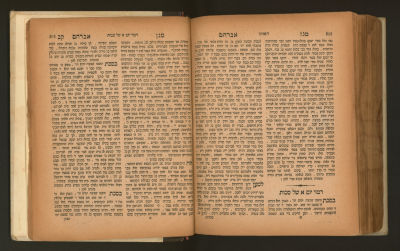Chassidic teachings of the Maggid of Trisk, with his introduction bearing a unique lithographic reproduction of the author’s signature, under his promise that this sefer will bring its owners benefit, and his blessings the fulfilment of all their wishes, with children and grandchildren …’.
He adds: "I have called this sefer "Magen Avraham"… because it will be a magen (protection) for all those who peruse it…"
With a lithograph of the author’s signature and handwriting, “ These are the words of the petitioner for Klal Yisrael and for the people who will buy this Sefer for their own good, for all times.”
In the name of the holy Rav the Sefas Emes of Ger it is said that "it is the duty of every Avrech, in the first year after his marriage, to pawn his Talis and Tefillin to purchase this holy Sefer’.
Lublin 1886. Two parts. First edition.
Two title pages for part I, additional title page for part II. Title and imprint in red.
[1], 47, 36; 113 leaves. 23 cm. (Some copies were printed on 114 leaves, here page 113 has more text squeezed in using smaller typeface.
Rebbi Avraham Twerski was born in 1806 to his saintly father, Rebbi Mordechai of Chernobyl. He had a very close relationship with his father and merited joining him on his journeys. Rebbi Avraham married the daughter of Rebbi Yaakov Aryeh Leib Schapira of Koblo, son of Rebbi Mordechai of Neshchiz. Following his marriage, he settled in Trisk, Ukraine where he served as a Maggid, eventually gaining fame as the ‘Maggid of Trisk’. Following his father’s passing in 1838, he assumed a mantle of leadership. He founded the Trisk Chassidut in his town, becoming its first Admor. Myriads of Chassidim flocked to his court, including many great Polish Admorim, who brought their own followers along on Shabbatot and Holidays.
In 1887, two years prior to his passing, Rebbi Avraham printed this Sefer, Magen Avraham, in two volumes. It is compiled of homiletic explanations on the Torah according to Chassidic tradition. It was printed in Lublin, from his followers’ transcriptions, and thereafter reprinted numerous times. It was widely accepted as a fundamental Chassidic work on faith, humility and holiness.
He passed away in 1889 and was buried in Trisk. Up until the Holocaust, his burial place was a popular place of prayer drawing thousands of his followers.






























